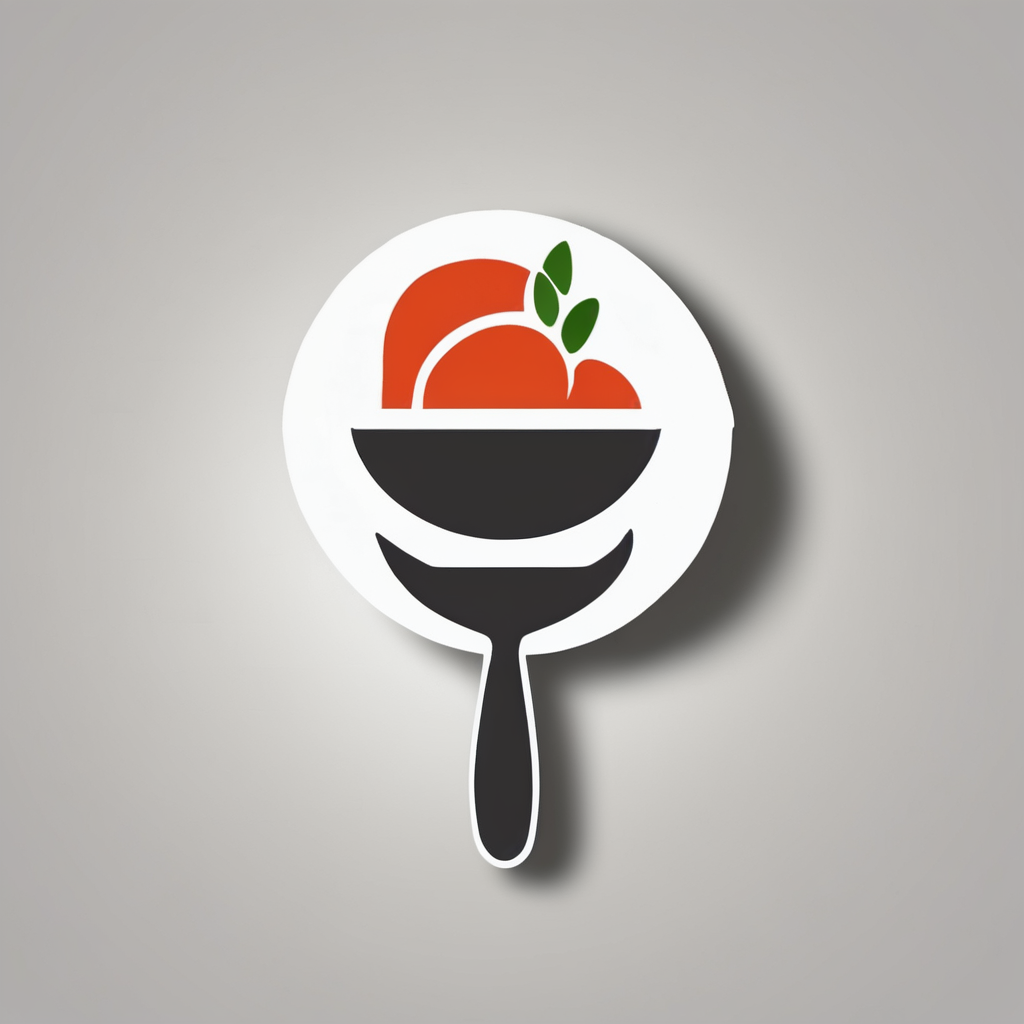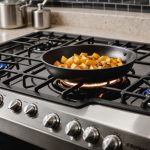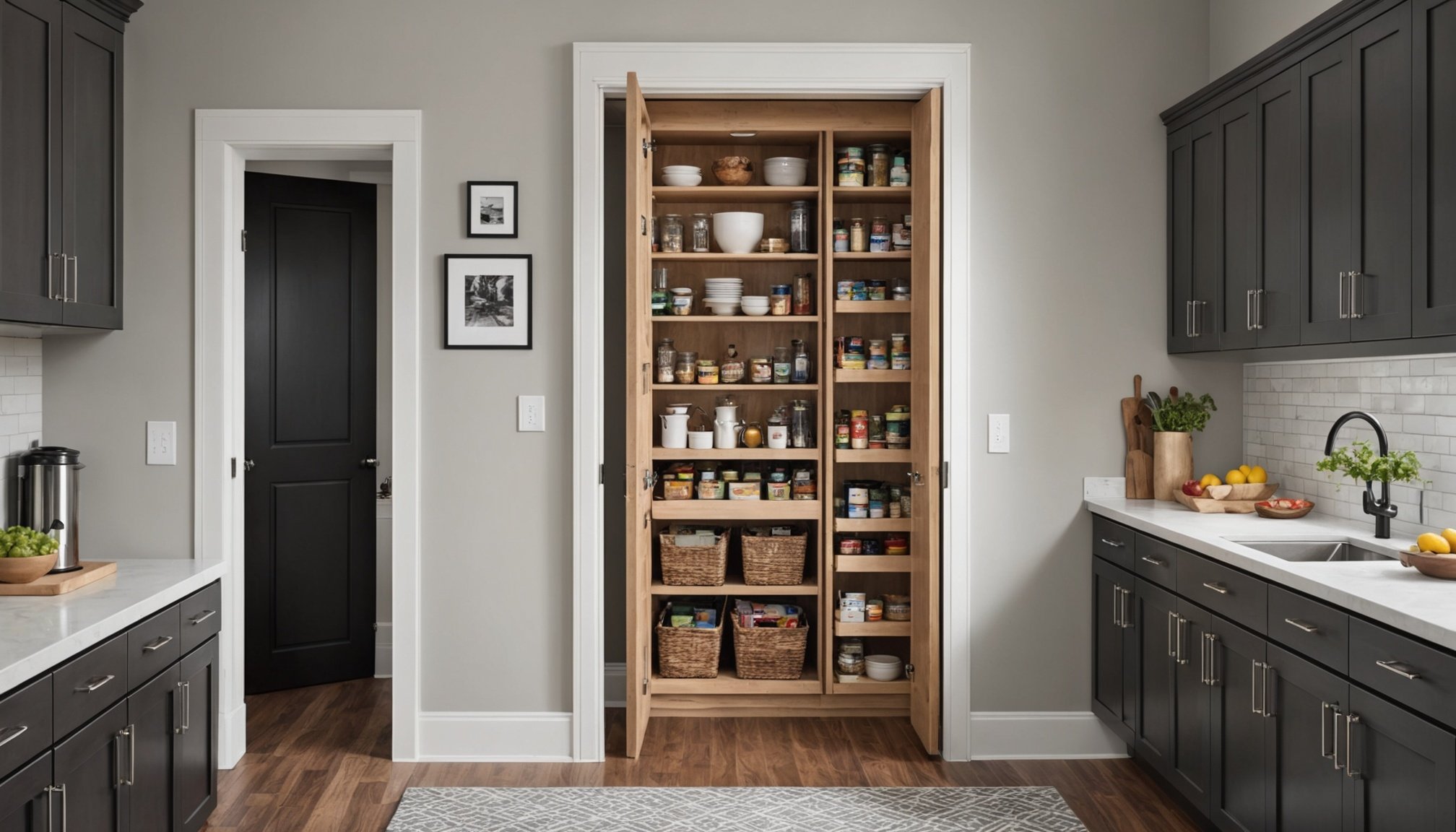Smart Solutions: Innovative Ideas for Incorporating a Walk-in Pantry in Your Compact Kitchen Layout
When it comes to optimizing your kitchen space, especially in smaller kitchens, incorporating a walk-in pantry can be a game-changer. Here’s how you can make the most of this often-overlooked area to enhance your kitchen’s functionality and aesthetics.
Understanding the Importance of a Walk-in Pantry
A walk-in pantry is more than just a storage space; it’s a hub for organizing your food, cooking supplies, and other kitchen essentials. In small kitchens, where every inch counts, a well-designed walk-in pantry can make a significant difference.
Also to read : Revamp your kitchen for optimal energy savings: discover the keys to eco-friendly cooking
“Utilizing every available space is crucial in small kitchens. A walk-in pantry can be a treasure trove for storage, keeping your kitchen clutter-free and organized,” says Heleen Neels, an expert in home optimization[3].
Assessing Your Space
Before you start designing your walk-in pantry, it’s essential to assess the space you have available. Here are some key factors to consider:
Also read : Transform your kitchen with the enchantment of multi-hued led lighting: a guide to atmosphere enhancement
Measure Your Space
Take precise measurements of the area where you plan to install your walk-in pantry. Consider the width, height, and depth to ensure you can fit all the storage solutions you need.
Identify Your Needs
Think about what you need to store. Do you have a lot of canned goods, spices, or baking supplies? Knowing what items you’ll be storing will help you design the pantry more effectively.
Choose the Right Location
Ideally, your walk-in pantry should be located near the main cooking area for easy access. However, if space is limited, consider using a corner or an underutilized area like the space under the stairs.
Designing Your Walk-in Pantry
Designing a walk-in pantry involves more than just installing shelves. Here are some innovative ideas to make the most of your space:
Use Vertical Space
Maximize your pantry’s vertical space by using floor-to-ceiling shelves. This will help you store more items without taking up too much floor space.
| Shelf Type | Benefits |
|
|--------------------------------------------------------------------------|
| Adjustable Shelves | Allows for customizable storage to fit items of different sizes |
| Fixed Shelves | Provides stability and is ideal for heavy items |
| Sliding Shelves | Offers easy access to items at the back of the pantry |
| Spice Racks | Keeps spices organized and within easy reach |
| Basket Shelves | Adds a decorative touch while keeping items like snacks or fruits tidy |
Incorporate Multifunctional Storage
Use multifunctional storage solutions like cabinets with drawers, baskets, and hooks. These can help keep your pantry organized and make the most of the available space.
- **Drawer Cabinets**: Ideal for storing small items like spices, oils, and condiments.
- **Basket Shelves**: Great for storing snacks, fruits, and other items that need to be easily accessible.
- **Hooks**: Perfect for hanging items like aprons, tea towels, or even pots and pans.
Opt for Compact and Modular Designs
In small kitchens, compact and modular designs are essential. Consider using modular pantry systems that can be customized to fit your specific needs.
“Modular pantry systems are highly versatile and can be tailored to fit any kitchen layout. They offer a range of storage solutions, from shelves to drawers, making them ideal for small kitchens,” advises a kitchen design expert[4].
Innovative Pantry Ideas for Small Kitchens
Here are some innovative pantry ideas specifically designed for small kitchens:
Corner Pantry
Utilize the often-wasted space in the corners of your kitchen with a corner pantry. This can be achieved using carousel shelves or corner baskets.
Hidden Pantry
If you don’t have a dedicated space for a pantry, consider creating a hidden pantry. This can be done by converting a closet or using a sliding door to conceal the pantry area.
Butler Pantry
A butler pantry is a great option for small kitchens. It acts as a transitional space between the kitchen and dining area, providing additional storage and counter space.
Practical Tips for an Organized Pantry
Keeping your pantry organized is crucial for maintaining its functionality. Here are some practical tips:
Label Your Shelves
Labeling your shelves helps you quickly find what you need and ensures that everything has its designated place.
Store Frequently Used Items Front and Center
Keep frequently used items at eye level and easily accessible. This saves time and reduces clutter.
Use Airtight Containers
Store food items in airtight containers to keep them fresh and organized. This also helps in maintaining a clean and pest-free pantry.
Choosing the Right Door for Your Pantry
The door of your pantry is more than just an entry point; it can also be a design element. Here are some options to consider:
Sliding Door
A sliding door is ideal for small kitchens as it saves space and provides easy access to the pantry.
Bifold Door
A bifold door is another space-saving option that can be used to conceal the pantry area when not in use.
Glass Door
A glass door adds a touch of elegance and allows you to see what’s inside without having to open the door.
Real-Life Examples and Anecdotes
Here’s an example of how one homeowner transformed a small kitchen by incorporating a walk-in pantry:
“I had a very small kitchen with limited storage space. By converting a closet into a walk-in pantry, I was able to store all my kitchen essentials in one place. It not only made my kitchen more organized but also freed up a lot of space,” says Sarah, a homeowner who recently renovated her kitchen.
Incorporating a walk-in pantry into your compact kitchen layout is a smart solution that can significantly enhance the functionality and aesthetics of your kitchen. By assessing your space, designing it thoughtfully, and using innovative storage solutions, you can create a pantry that is both organized and accessible.
Remember, the key to a successful walk-in pantry is to make the most of the available space while ensuring easy access to all your kitchen items. With the right design and storage solutions, your small kitchen can become a culinary haven.
Table: Comparing Different Pantry Designs
| Pantry Design | Benefits | Drawbacks |
|---|---|---|
| Corner Pantry | Utilizes wasted corner space, easy access | Limited storage capacity, may require custom installation |
| Hidden Pantry | Conceals the pantry area, adds a touch of elegance | May require more effort to access, limited visibility |
| Butler Pantry | Provides additional counter space, transitional area between kitchen and dining | Requires more space, may not be suitable for very small kitchens |
| Walk-in Pantry | Offers ample storage space, easy access | Requires dedicated space, may not be feasible in very small kitchens |
Image Credit: For examples of pantry designs, you can refer to home decor websites or consult with a kitchen design expert.
By following these tips and ideas, you can create a walk-in pantry that not only enhances your kitchen’s storage space but also adds a touch of elegance and functionality to your home.
Understanding the Importance of a Walk-In Pantry in Small Kitchens
In compact kitchens, a walk-in pantry plays a vital role in enhancing functionality and maximizing storage. As kitchens shrink in size, finding effective ways to house groceries, kitchenware, and other necessities becomes crucial. A well-designed pantry offers a clever solution for space optimization, allowing homeowners to store items efficiently.
One of the primary benefits is the significant boost in accessibility and organization. Everything from spices to appliances finds its rightful spot without causing clutter. This ensures that kitchen essentials are not just stored but are easy to reach and return, saving valuable time during meal preparations. In small kitchens, each inch counts, and a walk-in pantry taps into normally underused areas, creating organized space that appears almost magical.
Furthermore, a walk-in pantry contributes to improving the kitchen workflow and efficiency. By designating specific zones for various types of items, the cooking and cleaning process becomes much smoother. This reduces unnecessary trips back and forth, which, in a confined space, can be a significant advantage. Homeowners often find that a well-organized pantry fundamentally changes how they interact with their kitchen, making it more user-friendly and enjoyable to cook in.
Innovative Design Concepts for Walk-In Pantries
Designing a walk-in pantry offers a unique opportunity to create a functional yet stylish space in your kitchen. By using creative pantry designs, you can transform this often-overlooked area into a visual masterpiece.
Utilizing Vertical Space
The key to efficient pantry storage lies in maximizing every inch of available space. Utilizing vertical space is essential for creative pantry designs, as it allows you to store more items without increasing the footprint of the pantry itself. Consider installing tall shelving units that reach up to the ceiling. Not only do these shelves provide additional storage, but they also keep the items you use most often at eye level, improving accessibility.
Incorporating Custom Shelving
Custom shelving is another brilliant way to cater the pantry to your specific needs. These shelving solutions can be tailored to fit the exact dimensions and layout of your pantry, ensuring no space is wasted. With layout ideas that cater to your specific needs—like incorporating pull-out baskets or rotating carousels—you can make the most of your space while keeping everything organised.
Open vs. Closed Pantry Designs
Choosing between open and closed pantry designs is a matter of both function and aesthetics. Open designs provide easy access and can be a part of your kitchen’s visual appeal with aesthetically pleasing storage containers. In contrast, closed designs offer a cleaner appearance by hiding clutter and preserving a minimalist look.
Space-Saving Solutions for Incorporating Walk-In Pantries
Creating a functional walk-in pantry when space is at a premium requires creative space-saving strategies. Whether you’re inspired by the charm of a well-stocked pantry or the practicality of organized storage, these compact pantry solutions can fit into almost any home setup.
Clever Door Choices
When envisioning the entrance to a walk-in pantry, consider the use of clever door choices. Folding doors or pocket doors are excellent options for minimizing the space required to open and close doors. By tucking away seamlessly into the wall or folding neatly out of the way, these designs allow for more room to store essentials without obstruction.
Slimline Appliances
Selecting slimline appliances is a vital element of multi-functional design. Compact refrigerators, narrow dishwashers, and slender microwaves maximize storage and operational space within the pantry. The aesthetic of these appliances complements a seamless integration into the overall pantry design, offering utility without sacrificing style.
Sliding Shelves and Drawers
Implementing sliding shelves and drawers can revolutionize the way you utilise your pantry’s space. Sliding mechanisms grant easy access, even in tight spaces, allowing you to retrieve and store items with ease. This organisation system increases the functional range of your pantry, ensuring every inch is efficiently utilised.
Effective Storage Organization Tips for Small Walk-In Pantries
Transforming a small walk-in pantry into an efficiently organized space can seem like a daunting task. However, with thoughtful storage solutions and some creativity, you can maximize space and improve accessibility.
Categorizing and Labeling
One of the first steps to efficient pantry organization is categorizing items. Group similar items together, like spices, canned goods, and baking supplies. Label each category clearly, ensuring that everything has its place, facilitating easy access and restocking.
Using Storage Bins and Baskets
Storage bins and baskets are indispensable tools in maximizing space within your pantry. They not only help in keeping things tidy but also in enhancing accessibility. Use different sizes of bins to hold items according to their category. Transparent bins are particularly useful as they allow you to see contents at a glance, cutting down the time spent searching for items.
Rotating Stock for Freshness
Regularly rotating your stock is crucial in maintaining freshness, especially in smaller storage spaces. Always place newer items at the back and older ones at the front. This simple technique of inventory management ensures that items are used before their expiry, cutting down on waste and maintaining a well-organized pantry.
Material and Color Scheme Considerations
Understanding the importance of pantry materials and a cohesive color palette can significantly influence the functionality and aesthetics of your kitchen.
Choosing Durable Materials
Selecting the right materials is crucial. Durable pantry materials can withstand everyday wear and tear, ensuring longevity and ease of maintenance. Materials such as wood, metals, or composite options are popular for their resilience. For example, hardwood is not only fashionable but also provides a strong, lasting option for shelving and cabinetry. Consider materials that resist moisture, especially in humid climates, to prevent warping or mildew.
Color Psychology in Kitchen Design
The color palette you choose can greatly impact the overall feel of your kitchen. Light colors such as whites or pastels can make a small space appear larger and more open. Conversely, darker shades can create a cozy and warm ambiance. Colors can also affect your mood; blues and greens calm, whereas yellows and reds can invigorate and stimulate appetite. Opting for a harmonious color palette creates a unified and pleasing environment.
Climate Considerations for Pantries
Different environments demand various design adaptations. For instance, in warmer climates, choosing moisture-resistant pantry materials will help maintain structural integrity. Contrastingly, in cold regions, materials that retain heat can enhance energy efficiency. Adapt your design to suit specific climatic conditions while maintaining design cohesion in your kitchen.
Integrating Walk-In Pantries with Existing Kitchen Decor
Creating a cohesive design between your kitchen and a walk-in pantry involves a strategic approach. The objective is to ensure that both spaces complement each other harmoniously, reflecting an integrated style rather than appearing disjointed.
Harmonizing Styles
Matching the style of your pantry and kitchen is crucial for achieving kitchen integration. Begin by considering the overarching theme of your kitchen, whether it’s modern, rustic, or traditional. Use similar materials and finishes for shelves, doors, and storage units in your pantry. This alignment ensures each element feels like a natural extension of your kitchen’s aesthetic.
Creative Use of Lighting
Proper lighting is indispensable for both functionality and ambiance. Use under-cabinet lights to highlight pantry features and create a warm glow. Accent lights can enhance specific areas, while LED strips provide a modern touch. Good lighting not only enhances the appearance of the pantry but also ensures usability.
Accessory Coordination
Careful selection of accessories can harmonize your pantry and kitchen. Choose decor items that complement both spaces, such as matching storage containers or cohesive artwork. Integrate textiles like curtains or rugs that blend with the kitchen palette. Accessories should serve as a common thread, uniting the pantry and kitchen décor effectively.
Visual Examples and Case Studies
Exploring real-life inspirations through visual examples and pantry case studies can ignite the imagination of homeowners thinking about improving their pantry spaces. Whether you have sprawling storage or need a compact design, these examples are a treasure trove of ideas.
Successful Compact Pantry Designs
Compact pantry designs provide efficient storage solutions in small spaces. Consider a petite kitchen that utilises vertical shelving and pull-out baskets. This setup maximises space, keeping everything within reach without a lot of square footage. Another inspiring design features movable shelves, allowing easy reconfiguration to accommodate different items. These real-life inspirations not only meet storage needs but enhance kitchen aesthetics.
Before and After Transformations
The satisfaction of a well-executed renovation is unmistakable. In one before-and-after transformation, a cluttered corner was reimagined into a farmhouse-style pantry with sliding barn doors and rustic wood shelving. In another, minimalist cabinetry replaced wire racks, offering a sleek and clean finish. These examples demonstrate how thoughtful pantry enhancements can dramatically alter both style and function.
User Testimonials and Feedback
Gathering insights from users reflects the impact of practical design. One homeowner highlighted how pantry integration helped streamline their meal prep routines, saving time each day. Another praised the added convenience and organisation offered by their newly enhanced pantry setup. These testimonials underscore the value of personal feedback when considering a pantry project.











